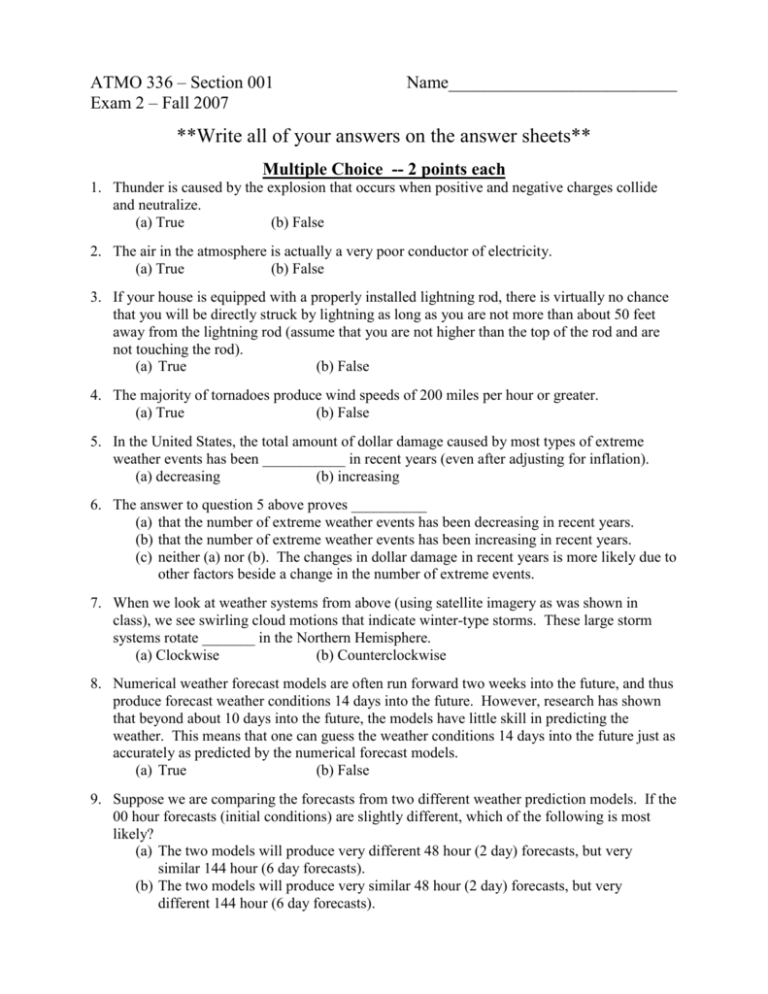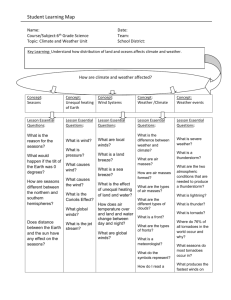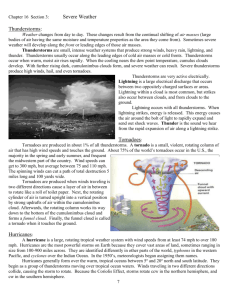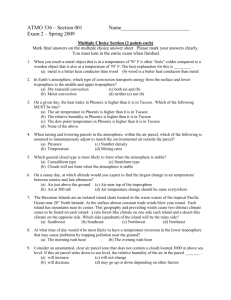Fall2007_Exam2
advertisement

ATMO 336 – Section 001 Exam 2 – Fall 2007 Name__________________________ **Write all of your answers on the answer sheets** Multiple Choice -- 2 points each 1. Thunder is caused by the explosion that occurs when positive and negative charges collide and neutralize. (a) True (b) False 2. The air in the atmosphere is actually a very poor conductor of electricity. (a) True (b) False 3. If your house is equipped with a properly installed lightning rod, there is virtually no chance that you will be directly struck by lightning as long as you are not more than about 50 feet away from the lightning rod (assume that you are not higher than the top of the rod and are not touching the rod). (a) True (b) False 4. The majority of tornadoes produce wind speeds of 200 miles per hour or greater. (a) True (b) False 5. In the United States, the total amount of dollar damage caused by most types of extreme weather events has been ___________ in recent years (even after adjusting for inflation). (a) decreasing (b) increasing 6. The answer to question 5 above proves __________ (a) that the number of extreme weather events has been decreasing in recent years. (b) that the number of extreme weather events has been increasing in recent years. (c) neither (a) nor (b). The changes in dollar damage in recent years is more likely due to other factors beside a change in the number of extreme events. 7. When we look at weather systems from above (using satellite imagery as was shown in class), we see swirling cloud motions that indicate winter-type storms. These large storm systems rotate _______ in the Northern Hemisphere. (a) Clockwise (b) Counterclockwise 8. Numerical weather forecast models are often run forward two weeks into the future, and thus produce forecast weather conditions 14 days into the future. However, research has shown that beyond about 10 days into the future, the models have little skill in predicting the weather. This means that one can guess the weather conditions 14 days into the future just as accurately as predicted by the numerical forecast models. (a) True (b) False 9. Suppose we are comparing the forecasts from two different weather prediction models. If the 00 hour forecasts (initial conditions) are slightly different, which of the following is most likely? (a) The two models will produce very different 48 hour (2 day) forecasts, but very similar 144 hour (6 day forecasts). (b) The two models will produce very similar 48 hour (2 day) forecasts, but very different 144 hour (6 day forecasts). Locate the points marked A-D on the 500 mb map above to answer questions 10-15 10. At which point do you expect temperature to be the most below average? (a) A (b) B (c) C (d) D 11. At which point do you expect temperature to be the most above average? (a) A (b) B (c) C (d) D 12. At which point do you expect the best chance for precipitation? (a) A (b) B (c) C (d) D 13. At which point is the 500 mb wind direction closest to northwesterly (use the meteorological definition for wind direction)? (a) A (b) B (c) C (d) D 14. The average 500 mb height over Tucson on October 25 is about 5775 meters. Based on this information and the map above, make a forecast for Tucson. (a) Sunny with about average temperatures (b) Sunny with above average temperatures (c) Cloudy and possibly rainy with about average temperatures (d) Cloudy and possibly rainy with below average temperatures 15. The closed low over Florida is the 500 mb projection of Hurricane Wilma. Based on this map which way would you expect Wilma to move? (a) Toward the southwest, exiting Florida, then moving out over the Gulf of Mexico (b) Toward the northwest, remaining over land as it tracks over the southeastern US (c) Toward the northeast, exiting Florida, then remaining just off the US coast (d) There is not enough information provided here to make a useful prediction 16. Which typically takes more time? (a) A commercial flight from San Francisco to New York (b) A commercial flight from New York to San Francisco (c) On average, both flights should take about the same amount of time Multiple Choice -- 3 points each 17. In the region immediately surrounding the eye of a hurricane, the horizontal air flow near the water surface is ______ , and the horizontal air flow aloft near the top of the troposphere is ________ . (a) diverging (flowing out) ; diverging (flowing out) (b) diverging (flowing out); converging (flowing in) (c) converging (flowing in); diverging (flowing out) (d) converging (flowing in); converging (flowing in) 18. The peak in the Atlantic hurricane season is centered around ____________ . (a) September 10 (b) August 10 (c) July 10 19. On average, which ocean basin produces the most hurricanes per year? (a) Western South Pacific (near Australia) where they are called severe tropical cyclones (b) Eastern North Pacific (off west coast of Mexico) (c) North Atlantic Ocean (d) Western North Pacific (near southeast Asia) where they are called typhoons 20. If golf ball sized hailstones are falling which of the following must be true? (a) The thunderstorm cloud is abnormally cold. (b) A tornado is nearby. (c) The thunderstorm contains strong updrafts. (d) There must be very strong vertical wind shear. 21. Severe thunderstorms are more likely to form where there is ______________ because this ___________________ . (a) strong vertical wind shear ; forces updrafts and downdrafts to mix (b) strong vertical wind shear ; helps keep updrafts and downdrafts separated (c) no vertical wind shear ; helps keep updrafts and downdrafts separated (d) no vertical wind shear ; forces updrafts and downdrafts to mix 22. The inside of a car provides relatively safe shelter from ________ . (a) Lightning (c) Both lightning and tornadoes (b) Tornadoes (d) Neither lightning nor tornadoes 23. On average, which type of severe weather kills the most people each year? (a) Hurricanes and Tropical Storms (b) Thunderstorms, including tornadoes, lightning, hail, and wind (c) Flash Flooding (d) Heat and Cold Waves 24. If you see a lightning stroke and then 30 seconds later hear the thunder, the lightning is about ________ miles away. (a) 10 (b) 6 (c) 3 (d) 1 25. Salt Lake City, UT is 1320 m (4330 ft) above sea level Las Vegas, NV is 663 m (2174 ft) above sea level Which city will have the lowest station air pressure (i.e., measured with a barometer)? (a) Always Salt Lake City (b) Always Las Vegas (c) Sometimes Salt Lake City, Sometimes Las Vegas 26. Salt Lake City, UT is 1320 m (4330 ft) above sea level Las Vegas, NV is 663 m (2174 ft) above sea level Which city will have the lowest equivalent sea level pressure? (a) Always Salt Lake City (b) Always Las Vegas (c) Sometimes Salt Lake City, Sometimes Las Vegas 27. Rising vertical air motion _______________ (a) will more likely be found in the vicinity of a surface high pressure area (b) will more likely be found in the vicinity of a surface low pressure area (c) is not at all affected by surface air pressure 28. Which is the correct order for the radiation energy carried by different types of photons from greatest to least? (a) ultraviolet, infrared, visible (b) ultraviolet, visible, infrared (c) infrared, visible, ultraviolet (d) infrared, ultraviolet, visible 29. On a sunny day, ultraviolet exposure at 10 AM (solar time) is _______ the ultraviolet exposure at 3 PM (solar time). (a) less than (b) greater than (c) about the same as 30. Which of the following is not one of the ways the human body protects itself from developing skin cancer? (a) Production of the pigment melanin (b) Repair DNA damaged by ultraviolet radiation (c) Protective outer layer of dead skin cells (d) Production of sweat to block ultraviolet absorption by the skin Short Answer Questions – 10 points each Everyone must answer #1. For #2 and #3, select either (a) or (b) 1. The incidence (number of reported cases) of skin cancer in the United States has been increasing at a rate of about 2% per year since 1981. This is a true statement. The rate of increase in southern Arizona has been even greater. After hearing this news a friend of yours says, “the increase in skin cancer in the US is the result of the ozone hole caused by CFCs.” Comment on the validity of your friend’s statement. Skin cancer rates in southern Arizona are among the highest in the US. Give three reasons why residents of southern Arizona are exposed to higher levels of ultraviolet radiation compared with most of the rest of the US. Provide a brief explanation for each reason. 2. Select either (a) or (b). (a) A large thunderstorm develops about 20 miles east of Tucson. Although Tucson does not get any rain initially, strong 40 mph winds from the east move in about a half an hour after rain began to fall from the thunderstorm to the east. What is the cause of the strong winds in Tucson? Be sure to fully explain how the strong winds develop. At about the same time the thunderstorm to the east began to produce rain, another thunderstorm about 20 miles west of Tucson began to produce rain. About 45 minutes after the two thunderstorms surrounding Tucson began raining, a new thunderstorm started to develop directly over Tucson. Explain how the two original thunderstorms may have acted to initiate the new thunderstorm over Tucson. (b) As described in lecture, supercell thunderstorms, which may produce violent tornadoes, sometimes form over tornado alley on days when the winds overhead come from three distinct sources: Lower troposphere: southeast winds transport warm, humid air from the Gulf of Mexico Middle troposphere: southwest winds transport hot, dry air from the Mexican highlands Upper troposphere: west winds transport cold air from the north Pacific Based on this information, point out some conditions that make the atmosphere favorable for the formation of supercell thunderstorms and tornadoes. The hot, dry air flow in the middle troposphere places a “convective cap” or “inversion layer” in the vertical temperature profile. What is a “convective cap”? How does the presence of the “convective cap” contribute to the development of violent supercell thunderstorms? 3. Select either (a) or (b). (a) A guest speaker on campus makes the following arguments: During the 2004 Atlantic hurricane season, three major hurricanes made landfall over the continental United States. In 2005, four more major hurricanes struck the U.S. coastline. This is the first time since 1850 that seven major hurricanes have made landfall over the continental United States in two consecutive hurricane seasons. The timing of these storms coincides with the warmest global average sea surface temperatures since 1850. He then draws the following conclusions: There is no doubt that the increase in destructive hurricanes striking the United States over the last two years is directly caused by global warming since we know that hurricanes need warm ocean water to form. Furthermore, we can expect to see increases in both the number and strength of hurricanes worldwide as sea surface temperatures continue to rise as a result of global warming. Are the speaker’s arguments basically correct or are they seriously flawed? Assuming that the arguments are correct, comment on the validity of the speaker’s conclusions. (Note: I am looking for a sensible discussion. There is not a single correct answer.) (b) The figure below indicates the current position of a category 2 hurricane and the hatched region shows the area covered by hurricane force winds. The 24 hour forecast is for the hurricane’s eye to make landfall at the Texas/Louisiana border as a category 2 hurricane. The hatched area on the coast indicates the land areas where hurricane force winds are expected to occur. The area on land between the two W’s marks the coastal areas that are put under a hurricane warning by the National Hurricane Center. Why is the hurricane warning area much larger than the area forecasted to get hurricane force winds? Assuming that the hurricane does make landfall exactly where predicted, where do you expect the most severe damage will occur? You need to explain the reason for your answer. Based on the course material, is there a realistic possibility of the storm becoming a category 5 hurricane before hitting the coast? Explain. (Assume that you know nothing about the sea surface temperature or wind shear over the Gulf of Mexico.) 4. Select either (a) or (b). (a) The 500 mb winds over the United States in the winter generally blow in which direction (from east to west OR from west to east)? Explain why. In your answer, you must explain why the average 500 mb height pattern looks like it does as well as how and why wind direction is related to this pattern. We said in class that the 500 mb winds are strongest where the height contour lines are closely spaced and weakest where the lines are spread apart. Explain why this is so. (b) Two basic types of low pressure systems are called “cold core lows” and “warm core lows” as shown in the figure below. In both types the “L” represents a low pressure area at the surface and “colder” and “warmer” compares temperature in the air column above the low with air columns surrounding the low. The warm core low is characteristic of a tropical cyclone. How did the air in the core (above the surface low) become warmer than the surrounding air? On a surface weather map, both low pressure areas appear as an “L” in the center, surrounded by several closed isobars. Describe the horizontal wind flow pattern just above the surface of the Earth near the warm core low. Would your answer be different for the cold core low? If yes, explain. The arrows on the diagram point upward from the ground surface and the labels indicate that the fastest winds associated with the warm core low occur just above the ground surface (assume high enough to neglect friction with the ground) and decrease in speed as you move upward; while near the cold core low, windspeed is slowest just above the ground and increase in speed as you move upward. Briefly explain why the windspeed will become faster as you move upward near the cold core low and slower as you move upward near the warm core low.







